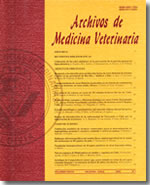Evaluation of the clinical-pathological and humoral immune response in rainbow trout fry (Oncorhynchus mykiss) experimentally infected with Infectious Pancreatic Necrosis Virus (IPNV)
Main Article Content
Abstract
The aim of this study was to assess the relationship between the clinical-pathologic process in rainbow trout fry (Oncorhynchus mykiss) infected with infectious pancreatic necrosis virus (IPNV) and the immunoglobulin M (IgM) levels in blood serum. Parameters were evaluated up to 45 days post infection (dpi) in fish intraperitoneally inoculated (IP) with 1X104 TCDI of IPNV, with minimal essential medium (MEM) and in the control group. Infected fish showed classical signs of infectious pancreatic necrosis (IPN) disease since day 19 pi, reaching 70% of accumulated mortality, and the survivor fish showed emaciation and IgM blood serum levels which progressively increased up to its maximum peak at day 31 pi; the most significant histopathological changes were the increase in melanomacrophage centers in the kidney, pancreatic necrosis and catarrhal enteritis. Viral isolation was possible only in the infected fish starting at day 3 pi up to day 45 (P > 0.5). The results suggest that even though the fish infected with IPNV can develop a humoral immune response characterized by the increase in IgM levels, this is insufficient to develop protection because while IgM levels are increasing, so does the viral title accompanied by clinical signs and histopathological injuries that are typical of the disease.

